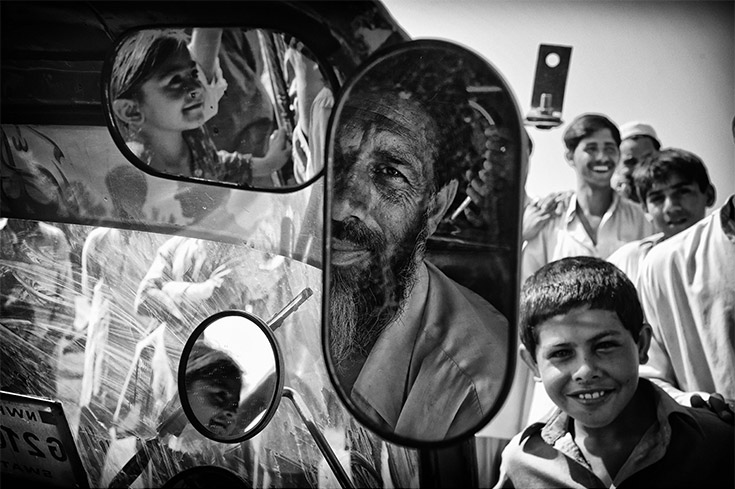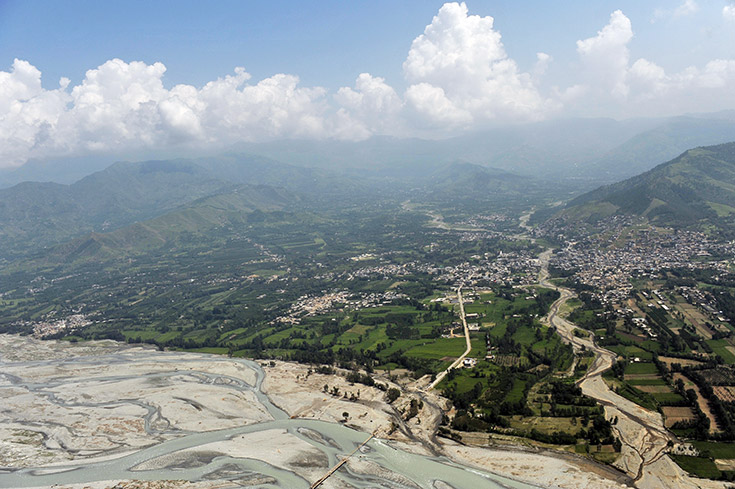Militancy in Swat: How lack of social justice fuelled the Taliban in Pakistan's North
I commissioned this piece by Hurmit Ali Shah because it helps give a better shape to understanding what really happened in Swat, how a place that was known for its beauty was turned into a chaotic hotbed of terrorist activity. Swat helps teach Pakistan many lessons in the kind of elements that can drive terrorist sentiments and support, writes Pakistan Blog Editor Luavut Zahid.
Pakistan has been haunted by religious-inspired extremism and terrorism for a good part of the last decade. Some extremist and terrorist groups have global aspirations, while others exploit certain sectarian divisions.

Sher Zaman, 50, squeezed 10 people into his LPG-powered auto-rickshaw on his flight from Swat Valley to the city of Mardan as some three million refugees poured out of Swat as the Pakistan army launched a massive operation to eliminate Taliban militants, after the breakdown of a peace deal in early May 2009 (photo: KPA/Zuma/REX Shutterstock)
All these organisations present socio-economic prosperity as one of their ultimate goals. One militant movement, which rose astronomically to the level of local insurgency, stands out above all the others. When it comes to garnering support for their cause – militant, financial and social – the Tehreek Taliban Swat (later becoming the Swat branch of Tehreek Taliban Pakistan) is different.
The movement is peculiar because its escalation into militancy engulfed the entire Swat region. The area, previously known for its beauty and tourism, was turned upside down. However, the upturning of its local social fabric is even further overshadowed by the perplexity of people of the region. How did this serene and lush green valley became a slaughterhouse of humanity? The only mention that the region gets in national and international media is through the extraordinary struggle and fascinating tale of Malala Yousafzai.
The reasons for militancy in the region, its causes, and consequences are unfortunately often explained away with broader generalisations. It is necessary to trace the socio-economic and political roots of this militant movement, defeating which is a feather in cap of Pakistan Army’s successes.
Swat is an administrative district located in the north of Khyber Pakhtunkhwa, Pakistan. At a distance of four or five kilometres by road and just on the opposite side of the river Swat from the main city Mingora, is town of Imamdherai, the ancestral village of Fazal Hayat, known as Fazlullah.
Fazlullah started his militant movement first by establishing a radio channel in 2002 (when he was released from captivity in Afghanistan, where his father-in-law Sufi Mohammad had commanded him to face US-NATO forces and fight alongside the Taliban facing the US-NATO forces). He also simultaneously constructed a large complex, which was to be a mosque, seminary hospital and much more.
The first financial support Fazlullah received from the people was for this complex, which he later expanded. It is strange that the news of this movement did not receive any attention when it was underway for almost five years and only came under scrutiny in July 2007 when Fazlullah announced Jihad on the state for the Lal Masjid operation in the Capital city of Islamabad.
The seminary complex provided the physical framework, his radio channel provided the missionary framework, while the ideological framework was provided by his encroachment of the socio-legal justice system of Islamic tradition.
His concept of social and speedy legal justice found resonance with the consciousness of the people of the area. When Fazlullah frequently hinted at the ‘Shariah Nizam,’ or Islamic system in his sermons, people listened. This same system was previously implemented in the region when it was ruled by a ‘Wali-e-Swat’ or guardian of Swat (a title the British had given to the ruler of Swat).
Militancy in Swat did not flourish in a vacuum. The contested notions that it was product of interpretation or misinterpretation of some parts of Islamic doctrine and the assertion that it was a kind of peasant revolt contains but only fractional truth. If the roots of initial popular support for the Fazlullah movement can be traced to a single point, it is to the failure of judicial system, which replaced the cheap and speedy justice system of the Swat state – whether that justice system was as per modern judicial standards and norms is another debate.
The Swat state was annexed by Pakistan in 1969; until then it had been ruled by a dynasty that established its rule in 1915. The Swat state was a social welfare state, which did well in establishing schools in every corner of the widespread and mountainous area.
Fazlullah’s was not the first attempt to galvanise people into support for his movement in name of social and legal justice. His father-in-law, Sufi Mohammad, in 1994 led a low-scale insurgency under the aegis of his organisation – Tehreek Nifaz-e- Shareet-e-Muhammadi (TNSM) – for implementation of the Islamic legal justice system, which was crushed by the Frontier Corps in three days.
The Army division dispatched under the command of then Major-General Pervaiz Musharraf was ordered to stay at nearby Dargai cantonment. The government, in order to quell any further rebellion, established the ‘Qazi’ or Islamic courts in the entire Malakand division, of which Swat is a part. The courts dealt primarily with familial disputes and other low scale civil legal disputes.
An important thing to understand is that the militancy was no peasant revolt. The leader of the movement Fazlullah, its representative Muslim Khan and its most ferocious and brutal commander Ibn-Ameen all belonged to landed gentry of the valley.
The argument that lack of development contributed to radicalisation in the valley is also not far-off. Swat has population of around 1.5 million and it had only one post-graduate college, which was established by the Swat state in 1952.4 The area had only two degree colleges at the time Fazlullah taking up arms ( detailed account of Swat state, its origins, its structure and its emphasis can be found in Swat State (1915-1969): From Genesis to Merger, by Sultan-I-Rome).

Swat Valley lies in the Mountainous Ranges of Pakistan, offshoots of Hindukush, and is home to giant ranges that enclose small valleys. It is an area of immense beauty, but has been subject to lack of infrastructure and radicalisation. Now, it is hoped that investment in employment and development, along with efforts to overcome radicalists, will bring a more peaceful and prosperous future for the region (Shutterstock / Thomas Koch)
The one central hospital in the valley was established by the Swat state, with the Pakistani government only adding a few blocks to it over a span of more than 30 years. One of the major sources of income for the valley is tourism, yet the terrible condition of the infrastructure and lack of proper marketing, hampered people from fully exploiting the area’s tourism potential. The lack of development and employment opportunities often provides solid grounds for radicalisation.
Fazlullah and his cohorts attracted people in name of the socio-legal justice in the beginning of his movement. By the time he went down the route of violence and radicalisation – enough to start militancy – almost the entire valley had withdrawn its support from him.
The call to arms and radicalisation went parallel with the siege at Lal Masjid, as the narrative of Lal Masjid preachers built-up to fanatic radicalisation, so the discourse of Fazlullah changed from emphasis on socio-legal justice to rabid militant radicalisation. The movement was avowedly religio-social that attracted popular support in its conception in the garb of larger social-legal justice.
Even at the height of militancy in the valley, Army officials claimed that the number of militants was no more than five thousand. Most of these militants were untrained and most of them fled the area once the conclusive military operation began.
Fazlullah was a shrewd manipulator of public opinion and rallied general dissatisfaction with socio-legal system around his vague notion of Islamic justice. The reverberation of his message found its way into the general popular conscience.
Later this radicalised segment of society enforced a narrow and fanatical version of religion through the sharp edges of knives and heavy guns, both of which silenced anyone presenting an alternative narrative, or even a question for Fazlullah’s interpretation of Islam.
The paths to radicalisation are many, but there are some that can be blocked by efficient delivery of justice, high standards of prosecution, social justice, and investment in development infrastructure. Sadly the Pakistani state only realised this and worked towards these objectives after thousands of people had died and thousands more were lost through radicalisation.
In the rehabilitation phase, after the final military operation, a regional high court bench was established, the number of sub-divisions in the district was increased to seven from two, lower courts were established in all subdivisions, the number of additional session courts was increased, a university was established, and a number of degree colleges were set up. Socioeconomic uplifting was emphasised, along with Infrastructure development through foreign aid.
The local tourism industry is now concentrated on new road networks. The ghosts of the dark days still haunt Swat valley in the form of target killings, but given the commitment of the state to infrastructure development and to speedy justice, a relapse to the dark days of militancy is avoidable.
Hurmat Ali Shah is a freelance columnist and PhD candidate. His work primarily focuses on society, politics and culture. He places an emphasis on the political and social issues present in Pakistan
References:
http://foreignpolicy.com/2013/11/08/who-is-mullah-fazlullah/
http://www.rawstory.com/2014/12/the-rise-of-maulana-fazlullah-the-ruthless-taliban-leader-who-ordered-the-peshawar-school-killings/
http://www.longwarjournal.org/archives/2008/05/pakistani_government.php
https://www.thebureauinvestigates.com/namingthedead/people/nd374/?lang=en
http://www.washingtonpost.com/wp-dyn/content/article/2009/05/30/AR2009053001090.html
https://en.wikipedia.org/wiki/Tehreek-e-Nafaz-e-Shariat-e-Mohammadi
http://www.dawn.com/news/1133198
http://nation.com.pk/politics/14-Apr-2009/Qazi-courts-start-working-with-full-authority-in-Swat
www.uswat.edu.pk
http://www.dawn.com/news/604202/donor-funding-shifts-to-public-sector-agencies
Luavut Zahid, 21/10/2015